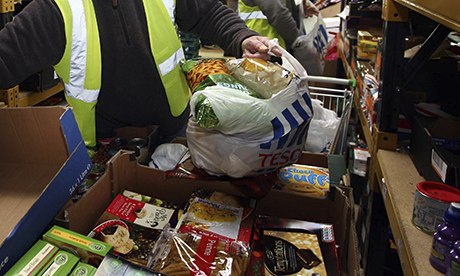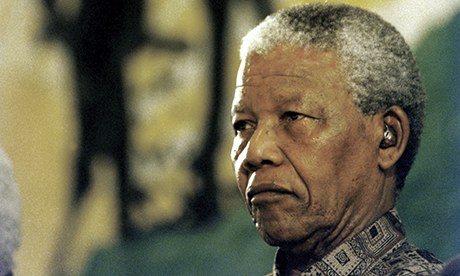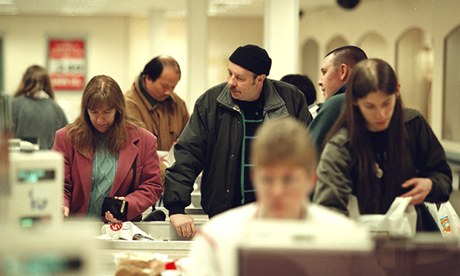We have iPads and broadband – but also oversubscribed foodbanks. Our economy is no longer zooming along unchallenged in the fast lane, but a clapped-out motor

A foodbank in the Black Country. Photograph: David Jones/PA
Elite economic debate boils down to this: a man in a tie stands at a dispatch box and reads out some numbers for the years ahead, along with a few micro-measures he'll take to improve those projections. His opposite number scoffs at the forecasts and promises his tweaks would be far superior. For a few hours, perhaps even a couple of days, afterwards, commentators discuss What It All Means. Last Thursday's autumn statement from George Osborne was merely the latest enactment of this twice-yearly ritual, and I bet you've already forgotten it.
Compare his forecasts and fossicking with our fundamental problems. Start with last week's Pisa educational yardsticks, which show British teenagers trailing their Vietnamese counterparts at science, and behind the Macanese at maths. Or look at this year's World Economic Forum (WEF) competitiveness survey of 148 countries, which ranks British roads below Chile's, and our ground-transport system worse than that of Barbados.
Whether Blair or Brown or Cameron, successive prime ministers and their chancellors pretend that progress is largely a matter of trims and tweaks – of capping business rates and funding the A14 to Felixstowe. Yet those Treasury supplementary tables and fan charts are no match for the mass of inconvenient facts provided by the Organisation for Economic Co-operation and Development, the WEF or simply by going for a wander. Sift through the evidence and a different picture emerges: Britain's economy is no longer zooming along unchallenged in the fast lane, but an increasingly clapped-out motor regularly overtaken by Asian Tigers such as South Korea and Taiwan.
Gender equality? The WEF ranks us behind Nicaragua and Lesotho. Investment by business? The Economist thinks we are struggling to keep up with Mali.
Let me put it more broadly, Britain is a rich country accruing many of the stereotypical bad habits of a developing country.
I began thinking about this last week, while reporting on graphene, the wonder material discovered by Manchester scientists and held up by cabinet ministers as part of our new high-tech future. Graphene is also the point at which Treasury dreaminess is harshly interrupted by the reality of our national de-development.
Briefly, the story goes like this: Osborne funnelled a few tens of millions into research on the substance. It's the kind of public-sector kickstart that might work in a manufacturing economy such as Germany – but which in Britain, with its hollowed-out industry and busted supply chains, has proved the equivalent of pouring money down a hole. One university physicist described how this was part of a familiar pattern of generating innovations for the rest of the world to capitalise on, then sighed: "One day, we'll stop thinking of ourselves as a major economic power, and realise we're more like South Korea in the early 60s." South Korea, by way of comparison, has already put in over 20 times as many graphene patents as the country that discovered it.
How can any nation that came up with the BBC and the NHS be considered in the same breath as India or China? Let me refer you to one of the first lines of The Great Indian Novel by Shashi Tharoor, in which a wise old man warns International Monetary Fund officials and foreign dignatories: "India is not, as people keep calling it, an underdeveloped country, but rather, in the context of its history and cultural heritage, a highly developed one in an advanced state of decay."
Stop thinking of development as a process that only goes in one direction, or which affects a nation's people equally, and it becomes much easier to see how Britain is going backwards.
Even banana republics have cash: it just ends up in the hands of a very few people – ask the bank managers of Switzerland or the hotel concierges of Paris. In Britain, we have become used to having our resources skimmed off by a small cadre of the international elite, who often don't feel obliged to leave much behind for our tax officials. An Africa specialist could look at the City and recognise in it a 21st-century version of a resource curse: something generating oodles of money for a tiny group of people, often foreign, yet whose demands distort the rest of the economy. Sure, Britain has iPads and broadband – but it also has oversubscribed foodbanks. And the concept of the working poor that has dominated political debate since the crash is also something straight out of development textbooks.
Nobel laureate Amartya Sen defined development as "the removal of various types of unfreedoms that leave people with little choice and little opportunity of exercising their reasoned agency". Yet when it comes to social mobility, Britain now has the worst record of all advanced countries – and will soon be overtaken by the newly rich countries of east Asia.
And it's when wealth is concentrated in too few hands that the forces of law and order get used as a militia for the elite – and peaceful dissent gets stamped upon. That's why police are now a presence on our business-friendly university campuses; it also explains why Theresa May had the front to try to deport Trenton Oldfield for disrupting a student rowing competition (sorry, the Boat Race).
This isn't a sub-Rhodesian moan about Britain going to the dogs. But as my colleague Larry Elliott said in his most recent book, Going South, the sooner we puncture our own complacency at having created a rich economy for the few, and think of ourselves as in dire need of a proper economic development plan, the better.
Otherwise, we're well set to corner the world market in pig semen. The United Kingdom of spoink.




